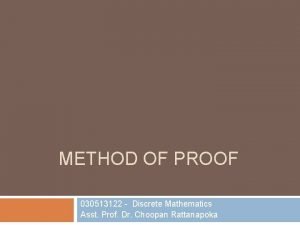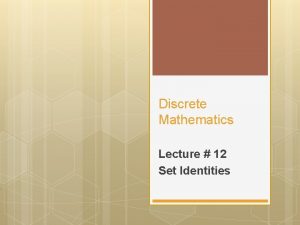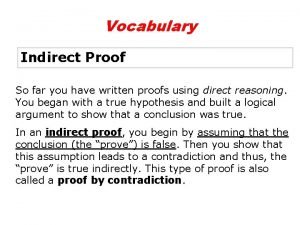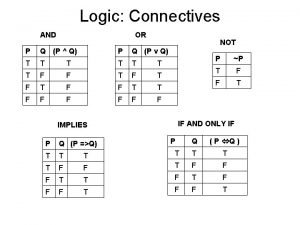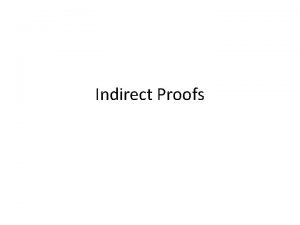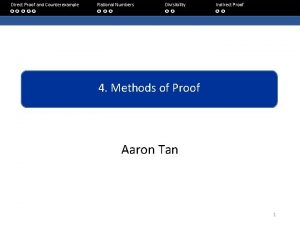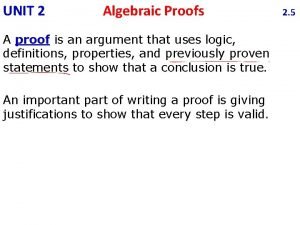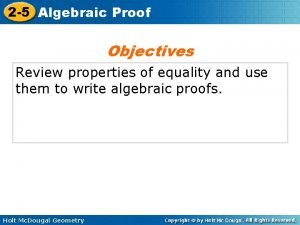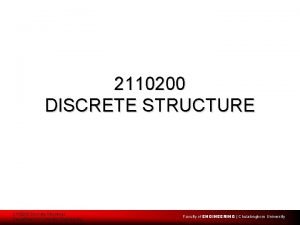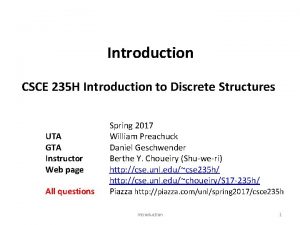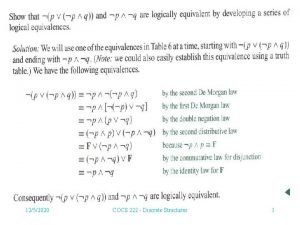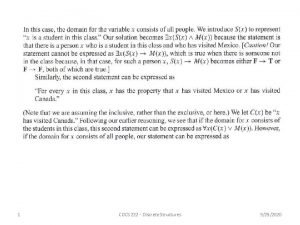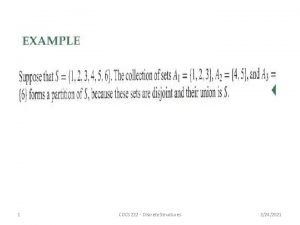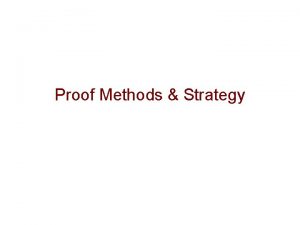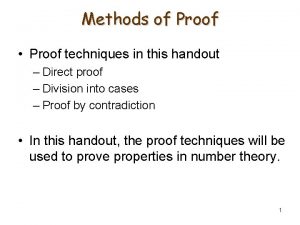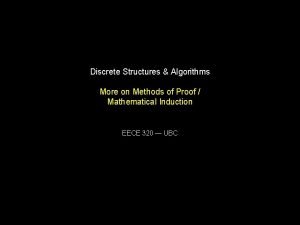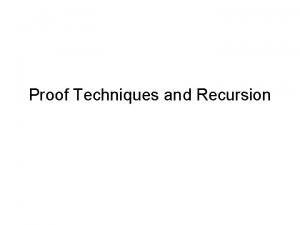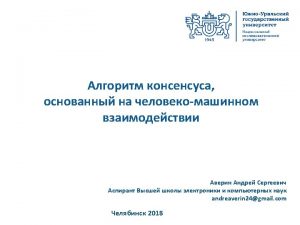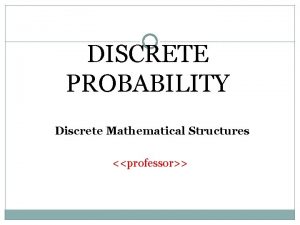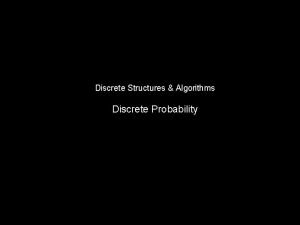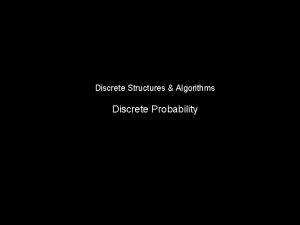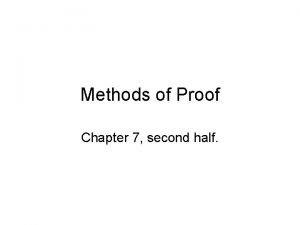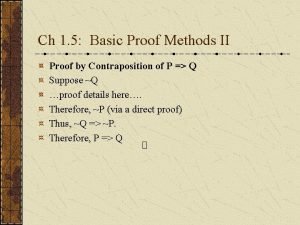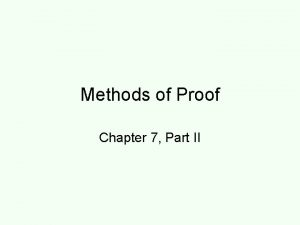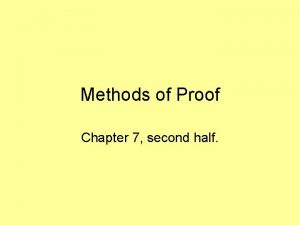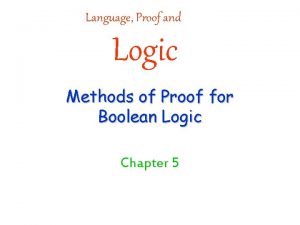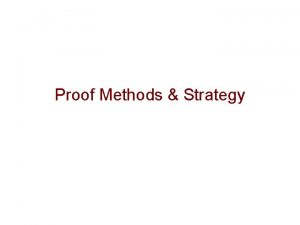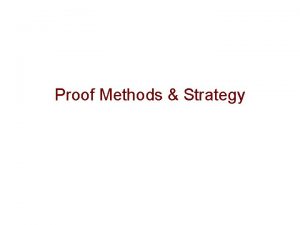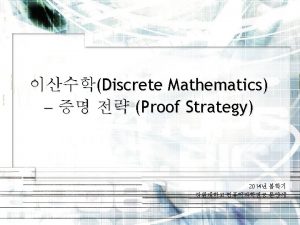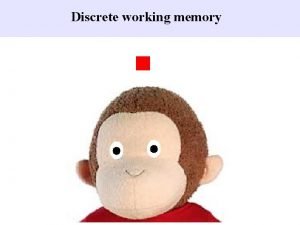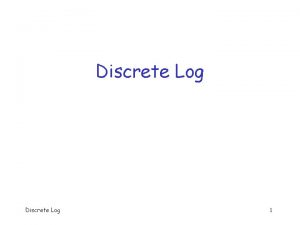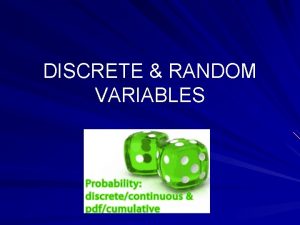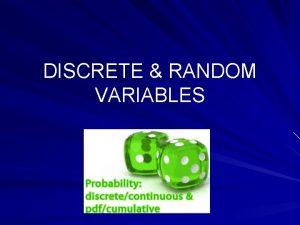Discrete Structures Algorithms More on Methods of Proof






































- Slides: 38

Discrete Structures & Algorithms More on Methods of Proof / Mathematical Induction EECE 320 — UBC

What have we explored so far Propositional logic Rules of inference Methods of proof 2

Problem: On an island live Greeks and Romans. Greeks always lie. Romans always tell the truth. You encounter two people: A and B. A says: “B is a Roman” and B says: “We are not the same people”. What are A and B? 3

Proof Methods For proving implications p q, we have: Direct proof: Assume p is true, and prove q. Indirect proof: Assume q, and prove p. Vacuous proof: Prove p by itself. Trivial proof: Prove q by itself. Proof by cases: Show p (a b), and (a q) and (b q). Proof by contradiction of any statements. Existence proofs: Constructive and nonconstructive 4

A Direct Proof Prove that an integer n is even, if n 2 is even. 5

A … Proof Prove that if n = a*b are positive integers then a sqrt(n) or b sqrt(n) 6

A … Proof Prove that the equation r 3 + r + 1 = 0 has no rational solution. 7

An existence proof (constructive or non-constrictive? ) Prove that there exist a and b irrational numbers such that ab is rational. 8

A few techniques • Forward / backward reasoning • Adapting existing proofs • Intermediary steps / Conjectures / Counter examples 9

Proving by induction 10

Dominoes Domino Principle: Line up any number of dominos in a row; knock the first one over and they will all fall. 11

Dominoes numbered 1 to n Fk = “The kth domino falls” If we set them up in a row then each one is set up to knock over the next: For all 1 ≤ k < n: Fk Fk+1 F 1 F 2 F 3 … F 1 All Dominoes Fall 12

Dominoes numbered 1 to n Fk = “The kth domino falls” k, 0 ≤ k < n: Fk+1 F 0 F 1 F 2 … F 0 All Dominoes Fall 13

The natural numbers = { 0, 1, 2, 3, . . . } One domino for each natural number: 0 1 2 3 … 14

Plato’s Dominoes One for each natural number Theorem: An infinite row of dominoes, one domino for each natural number. Knock over the first domino and they all will fall Proof: Suppose they don’t all fall. Let k > 0 be the lowest numbered domino that remains standing. Domino k 1 ≥ 0 did fall, but k-1 will knock over domino k. Thus, domino k must fall and remain standing. Contradiction. 15

Mathematical Induction statements proved instead of dominoes fallen Infinite sequence of dominoes Infinite sequence of statements: S 0, S 1, … Fk = “domino k fell” Fk = “Sk proved” Establish: 1. F 0 2. For all k≥ 0, Fk Fk+1 Conclude that Fk is true for all k 16

Inductive proofs To prove k , Sk Establish “Base Case”: S 0 Establish that k, Sk Sk+1 Assume hypothetically that Sk for any particular k fixed; Prove that Sk+1 17

Theorem? The sum of the first n odd numbers is n 2 Check on small values: 1 =1 1+3 =4 1+3+5 =9 1+3+5+7 = 16 18

Theorem? The sum of the first n odd numbers is n 2 The kth odd number is (2 k – 1), when k > 0 Sk is the statement that: “ 1+3+5+…+(2 k-1) = k 2” 19

Establishing that n ≥ 1 Sn Sk = “ 1 + 3 + 5 + …. + (2 k-1) = k 2” Base Case: S 1 Domino Property: Assume “Induction Hypothesis”: Sk That means: 1+3+5+…+ (2 k-1) = k 2 1+3+5+…+ (2 k-1)+(2 k+1) = k 2 +(2 k+1) Sum of first k+1 odd numbers = (k+1)2 20

Theorem The sum of the first n odd numbers is n 2 21

Primes: A natural number n > 1 is a prime if it has no divisors besides 1 and itself Note: 1 is not considered prime 22

? Theorem Every natural number > 1 can be factored into primes Sn = “n can be factored into primes” Base case: 2 is prime S 2 is true How do we use the fact: Sk-1 = “k-1 can be factored into primes” to prove that: Sk = “k can be factored into primes” 23

This shows a technical point about mathematical induction 24

? Theorem Every natural number > 1 can be factored into primes A different approach: Assume 2, 3, …, k-1 all can be factored into primes Then show that k can be factored into primes 25

“All previous” induction To prove k, Sk Establish Base Case: S 0 Establish Domino Effect: Assume j<k, Sj use that to derive Sk 26

All Previous Induction Also called To“Strong Prove k, Sk Induction” Establish Base Case: S 0 Establish Domino Effect: Assume j<k, Sj use that to derive Sk 27

“All previous” induction Repackaged As Standard Induction Define Ti = j ≤ i, Sj Establish Base Case: S 0 Establish Base Case T 0 Establish Domino Effect: Establish that k, Tk Tk+1 Let k be any number Assume Tk-1 Let k be any number Assume j<k, Sj Prove Sk Prove Tk 28

And there are more ways to do inductive proofs 29

Another way of packaging inductive reasoning is to define “invariants” Invariant (n): 1. Not varying; constant. 2. Mathematics. Unaffected by a designated operation, as a transformation of coordinates. 30

Invariant (n): 3. Programming. A rule, such as the ordering of an ordered list, that applies throughout the life of a data structure or procedure. Each change to the data structure maintains the correctness of the invariant 31

Invariant Induction Suppose we have a time varying world state: W 0, W 1, W 2, … Each state change is assumed to come from a list of permissible operations. We seek to prove that statement S is true of all future worlds Argue that S is true of the initial world Show that if S is true of some world – then S remains true after any permissible operation is performed 32

Odd/Even Handshaking Theorem At any party at any point in time define a person’s parity as ODD/EVEN according to the number of hands they have shaken Statement: The number of people of odd parity must be even 33

Statement: The number of people of odd parity must be even Initial case: Zero hands have been shaken at the start of a party, so zero people have odd parity Invariant Argument: If 2 people of the same parity shake, they both change and hence the odd parity count changes by 2 – and remains even If 2 people of different parities shake, then they both swap parities and the odd parity count is unchanged 34

Exercise Show that the sum of first N positive integers is N*(N+1)/2 35

Inductive reasoning is the high level idea “Standard” Induction “All Previous” Induction “Invariants” all just different packaging 36

Induction is also how we can define and construct our world. So many things, from buildings to computers, are built up stage by stage, module by module, each depending on the previous stages. 37

The essential elements of mathematical induction are: • The proposition of interest • The base case • The inductive step 38
 Lirik lagu more more more we praise you
Lirik lagu more more more we praise you More more more i want more more more more we praise you
More more more i want more more more more we praise you Methods of proof in discrete mathematics
Methods of proof in discrete mathematics Data structures and algorithms iit bombay
Data structures and algorithms iit bombay Princeton data structures and algorithms
Princeton data structures and algorithms Data structures and algorithms tutorial
Data structures and algorithms tutorial Information retrieval data structures and algorithms
Information retrieval data structures and algorithms Data structures and algorithms bits pilani
Data structures and algorithms bits pilani Ajit diwan
Ajit diwan Algorithms + data structures = programs
Algorithms + data structures = programs Data structures and algorithms
Data structures and algorithms Data structures and algorithms
Data structures and algorithms Waterloo data structures and algorithms
Waterloo data structures and algorithms Signature file structure in information retrieval system
Signature file structure in information retrieval system Data structures and algorithms
Data structures and algorithms Mathematics 1
Mathematics 1 Their identities are set
Their identities are set Direct proof and indirect proof
Direct proof and indirect proof Direct proof and indirect proof
Direct proof and indirect proof Proof that
Proof that Direct proof and indirect proof
Direct proof and indirect proof Algebraic proof
Algebraic proof Unit 2 logic and proof homework 6 algebraic proof day 1
Unit 2 logic and proof homework 6 algebraic proof day 1 Discrete structures
Discrete structures What is discrete math
What is discrete math Discrete computational structures
Discrete computational structures Discrete structures
Discrete structures Cs 584
Cs 584 Discrete structures
Discrete structures Proof methods and strategy
Proof methods and strategy Proof methods and strategy
Proof methods and strategy Proofs mathematics
Proofs mathematics Homologous structures and analogous structures
Homologous structures and analogous structures Direct wax pattern technique
Direct wax pattern technique The more you take the more you leave behind
The more you take the more you leave behind The more you study the more you learn
The more you study the more you learn Aspire not to have more but to be more
Aspire not to have more but to be more Define inertia
Define inertia Knowing more remembering more
Knowing more remembering more


